Guns at Annunciation
I was baptized at the church where kids were murdered. It's a canary in the coal mine for a dystopian America, where people blame everything but the real cause: a country awash with unlimited guns.
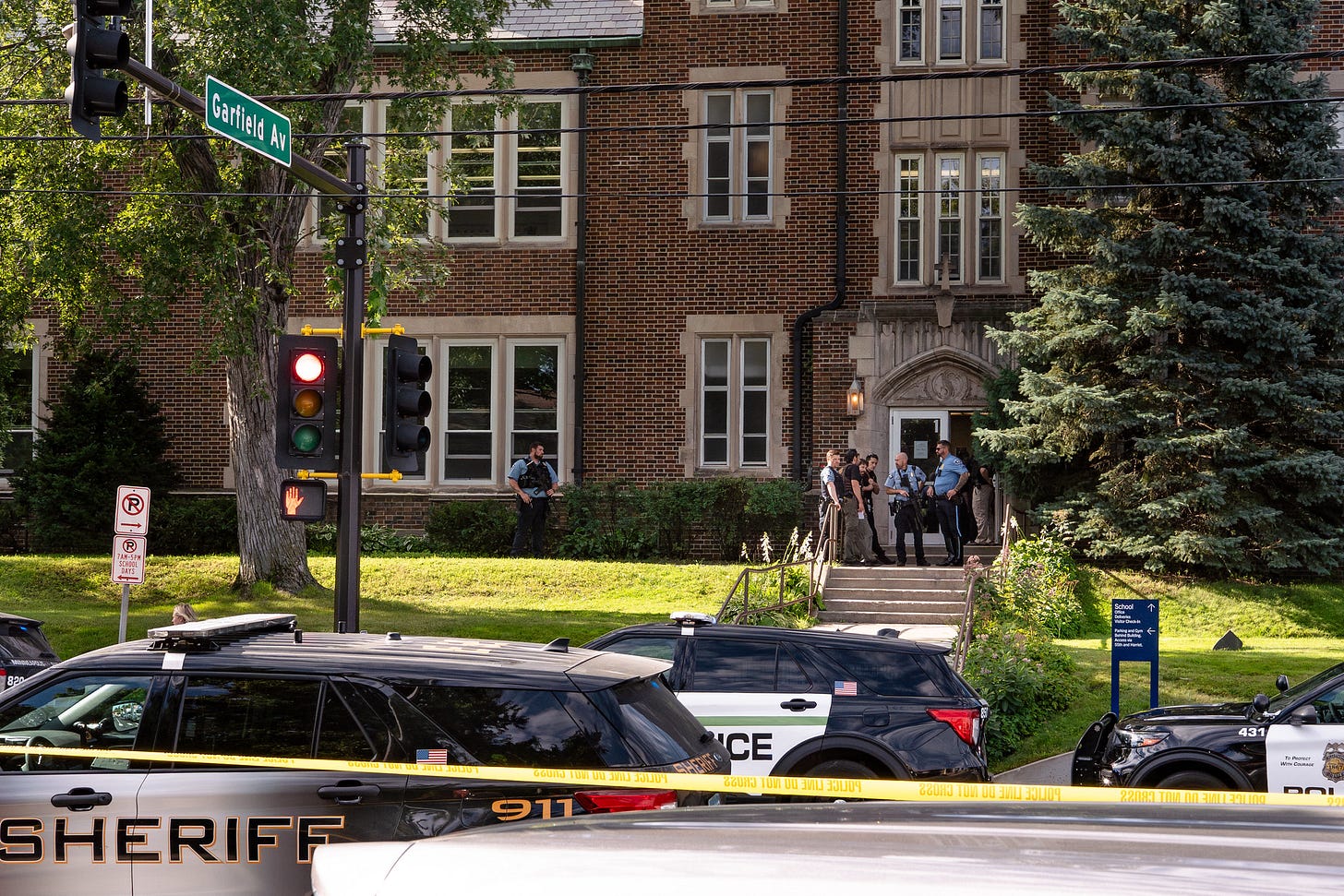
Thank you for reading The Garden of Forking Paths. This edition is free for everyone, but if you value my work and would like to support it, please consider upgrading for $4/month. It keeps this sustainable and also unlocks the full archive of 210+ essays and allows you to comment and discuss.
Two minutes
39 years ago, I was baptized in Annunciation Church in southwest Minneapolis, my parents and Godparents beaming, as light filtered through pale blue and golden stained glass windows behind them.1
Last Wednesday morning, a deranged, mentally unwell shooter with easy access to weapons of war and unlimited ammo, shattered those same windows while spraying bullets into children who were praying in pews.2 It was the first week back to school.
In less than two minutes, the shooter unloaded 116 rounds. As the glass exploded, a fifth-grader named Victor dove on top of another 10 year-old, shielding his tiny body from the armor-piercing NATO-grade military rounds—bullets that were bought legally nearby.3 Victor was shot in the back, but survived.4 Another student, wheelchair-bound Ryan Palattao, couldn’t duck under the pews. A heroic teacher named Becca Heer dragged him out of the chair, pinned him beneath her body, and saved his life.
The death toll could have been far worse. The door to the church was locked, forcing the shooter to attack from the outside. That detail was treated as an unequivocal positive—and thank goodness the door was locked that morning. But the door to a church being locked during services by default is also a dystopian canary in the American coal mine. Rather than dealing with the root problem, the United States has made political choices to live this way, where the only way to try to keep kids safe is to lock the world out.5
Bad faith
While parents were falling to their knees in crushing grief after being notified about the fate of their kids—dead, wounded, or physically unharmed but doomed to a lifelong sentence of psychological trauma—social media monsters were already letting their fingers dance gleefully across their keyboards as they cherry picked whatever narrative best suited their politics.
Before it was taken down, I watched the chilling pre-massacre video that the shooter posted on YouTube. (I do not recommend seeking it out; it was beyond disturbing.) But what struck me most was how many contradictory, convoluted ideologies were on display.
Anti-Trump, but deeply enamored with a pro-gun, pro-Trump YouTuber turned Congressional candidate. Racist, anti-Semitic, and Islamophobic. Brief comments about gender and sexuality. Diatribes about hating children and loving school shooters. Diary entries pleading for mental help, written in Cyrillic characters.
Everyone scrounged for clear-cut answers, as though this deranged killer was a fount of ideological coherence instead of the more obvious explanation: that they were suicidal, depressed, angry, and imbuing their own rampage with a series of impressionistic thoughts and pseudo-ideologies that were more stream-of-consciousness mutterings than philosophical manifesto.
The shooter even spelled it out for us, at one point writing: “The message is there is no message.”
And yet, for bad faith actors—a commodity in seemingly unlimited supply in American politics—it was like a “choose your own ideological scapegoat” game. The shooter’s incoherent ramblings offered enough elastic to give anyone the chance to trumpet their prior beliefs: “You see, my favorite pet outgroup is to blame for the killing of these innocent little kids.” Elected Republicans and political influencers seized on the fact that the shooter had changed her preferred gender identity to paint all transgender people as mentally ill and violent.
In addition to being bigoted and hateful, these approaches are a fool’s game. They center the shooter as the core focus of our understanding for any specific act of violence rather than keeping our attention on the structural triggers that can be changed to prevent future killings.
Deranged zealots, bigots, evil, hateful murderers, and mentally unwell people exist everywhere on the planet. There are people like the Minneapolis shooter in every country in the world. But routine mass shootings occur with regularity in just one developed rich country. Why is that?
There was something in the shooter’s video that offered a far better explanation than any incoherent manifesto ever could: a bewildering array of guns and an enormous cache of ammunition, all legally purchased.
There are three key factors that are relevant to understanding elevated levels of targeted, mass violence in the United States: social dysfunction, elite incitement, and above all, easy access to unlimited guns.
Social dysfunction—poverty, racial hatred, inequality, cultural anger, gang violence, a broken health care system, and so on—create a toxic cocktail that inevitably leads to elevated levels of violence compared to better functioning peer societies.
Incitement to violence and hate-filled polarization spewed from politicians, prominent public figures, and influencers in the media can amplify the risks further, particularly in terms of targeting specific groups.
For example, it is unlikely that Vance Boelter, the Christian extremist Minnesota assassin, would have killed Democratic politicians in a political culture that was built on tolerance and mutual respect. It was little surprise that someone like Boelter acted after years of asymmetric Republican demonization of their political opponents as “treasonous scum” who are secretly pedophiles, complete with outlandish conspiracy theories, violent memes, and jokingly praising would-be assasins or endorsing January 6th rioters as victims.
But both of these factors are dwarfed by the causal trigger that makes the United States a unique international outlier: easy, unfettered access to guns. It is currently a country with more political capital being spent on banning books than banning assault rifles. The ugly truth is this:
The United States is the only rich, developed nation in the world that politically tolerates and legally ensures the slaughter of its own citizens.
It’s the guns.
Last year, 17,927 people were murdered with a gun in the United States.
In England and Wales6, that same figure was 22. You didn’t read those numbers incorrectly. It’s really 17,927 vs. 22.
To insist on highlighting this point, here’s a visual representation of that data:
Now, it is true that the United States (≈340 million people) has a significantly larger population than England & Wales (≈62 million people). Lest you think I’m doing any statistical trickery, here are those same figures adjusted for population, the number of gun homicides per 100,000 people:
This isn’t cherry-picked data that simply looks bad because the UK is a particular outlier that’s free from violence. Instead, no matter how you slice the data (and the datasets do vary a little bit from year-to-year or from metric-to-metric) you get a broadly similar picture.
Here, for example, is the gun homicide rate in the United States compared to every other high-income country that has at least 10 million people.7 No other rich country comes close to American levels of gun homicides—and that’s even compared to the second worst, which is Saudi Arabia.
There are a million mental contortions that Republicans and pro-gun advocates use to try to explain these figures away. None of them make sense. “It’s mental health!”; or “It’s the violent video games!” These fantastical explanations imagine that the rest of the world is somehow populated by countries without mental health problems and devoid of violent video games.
There is precisely one factor that is an incredible, glaring outlier—and it correlates extremely well with national gun murder rates: the number of civilian guns in circulation and how easy it is to get them.
Here’s the relevant data (from the Small Arms Survey) based on estimated levels of gun ownership per 100 people. The United States is in 1st place and, again, it isn’t even close. America is the only nation with more guns than people. Yemen is in a distant second place. If you only know just one thing about Yemen, you probably know this: it’s bad news if you’re ranked anywhere near Yemen on any conceivable national metric.
Even the rich countries that have relatively high levels of firearm ownership (Canada, for example) have many more hurdles that must be cleared in order to walk out of the store with a gun in your hand—something that was not the case for the Annunciation Church shooter.
The New York Times made a visually striking comparison showcasing the number of steps one must go through before acquiring a personal gun in sixteen different countries. Compare, for example, the steps required in the United States vs. Canada and Japan.
To beat this dead horse just a little more, here’s a graphic from Politico showing the global map of countries where you don’t need a license to own a gun:
The combination of these factors—the number of guns and how easy it is to get an unlimited number of them—correlates extremely closely with gun murder rates.
Here’s another visual from The New York Times (using data from The Small Arms Survey) that makes such a compelling graphic that it’s hard to imagine anyone not recognizing the obvious relationship. It shows the number of guns per 100 people on one axis and the gun homicide rate on the other. (If you’re not seeing the US immediately, it’s over there in the top right corner, far away from all the other developed countries, but the clear trend line is easy to see.)
The knife replacement myth
Plenty of gun advocates try to explain away these data points by arguing that there’s a displacement effect: if you make it harder to get guns, you’ll just end up with other weapons being used in murders.
Taking aside the obvious point—that it’s harder to kill a huge number of people in a few minutes with, say, a knife or a hammer or your bare fists, compared to an AR-15 firing NATO rounds—there’s also the inconvenient fact that this simply isn’t true. The United States also has higher levels of knife murders than countries like the United Kingdom.
In the most recent available data, the United States had a rate of 0.53 stabbing deaths per 100,000 people, compared to 0.08 per 100,000 in the United Kingdom. It probably is true that if all the guns in America disappeared tomorrow, there would likely be some increase in other weapons used for murders, but it’s not the case that there’s just a straightforward displacement effect.
Reliable cross-country comparisons with knife murder rates are slightly harder to find, but these data — from Euronews — give a good snapshot of the rough comparisons between the US and the UK over a number of years (admittedly a few years out of date, now).
Moreover, the reason you rarely hear about “mass stabbings” is because it’s a hell of a lot harder to kill a lot of people quickly with a knife. But with mass shootings, the death toll can be horrific in a matter of minutes. In 2017, the shooter in Las Vegas unleashed more than 1,000 bullets in less than ten minutes, nearly two bullets per second. He killed sixty people. At least 413 other people were shot but survived. In just ten minutes.
According to the Gun Violence Archive, which diligently tracks the data, there were 503 mass shootings in the United States last year (2024). In the United Kingdom, there was one mass shooting, in which four people were injured and nobody died. If you add up all the mass shootings that have taken place in the United Kingdom in the 21st century—over the last 25 years—the total death toll is lower (59 deaths) than the ten minutes of carnage in one mass shooting in Las Vegas (60 deaths).
Terrifying “active shooter” incidents—with a gunman on the loose roaming around and murdering people in populated areas—also have a clear upward trend in the United States (despite a slight decline in recent years). Here’s the relevant chart from Pew Research:
Lying and Deflecting
Republican elected officials, including pro-gun zealot Lauren Boebert, have spread the lie that other murder weapons like hammers are more commonly used to kill people than guns in the United States.
This is a straight-up lie. In 2023, the most recent data analyzed, there were 22,830 murders in the United States. 17,927 of them were perpetrated with a gun—79 percent of the total.
Another common refrain from pro-gun advocates is that the problem is mental health issues, not guns. As I previously wrote:
It’s extremely clear that the overwhelming majority of people with mental illness are non-violent. According to Jeffrey Swanson, a professor in psychiatry and behavioral sciences at Duke University, quoted in Bloomberg: “If we magically cured all these serious mental illnesses tomorrow, which would be wonderful—imagine the alleviation of suffering—our violence problem would go down by about four percent.”
Now, it is true that America’s mental health services are abysmal for people who are uninsured or under-insured, which isn’t the case in countries that have stronger healthcare safety nets. But even if mental health were a major contributing factor to gun violence, keep in mind that it’s Republicans who almost always vote against funding increases for mental health support services. The very people who wrongly claim that gun violence comes from mental health problems are the ones who vote against funding mental health programs.
In April, the Trump administration cut $1 billion for a program that tried to provide mental health support in educational settings to prevent school shootings. Congress, controlled by Republicans, has not tried to reinstate it.
Separately from mental health, Trump’s Justice Department recently slashed the number of firearm dealer inspectors by two-thirds. These are the people who go around and make sure that people who sell guns aren’t selling them to criminals, people with a documented history of mental illness, or straw purchasers who then sell them to criminals. There used to be 800 inspectors; now there will be 259. That leaves fewer than 300 inspectors to police the sale of 15 to 20 million guns per year.
The most infuriating—and persistent—false claim about America’s gun violence epidemic is that gun control doesn’t work. The argument goes like this:
Democratic-run cities have more gun control;
Democratic-run cities have lots of murders;
Therefore, gun control is ineffective.
As I’ve explained previously, this is incredibly stupid logic with basic errors in even the most rudimentary critical thinking:
There are two glaring problems with this argument. The first is obvious: cities have larger populations, more crime, and more gangs than sparsely populated areas (this is true everywhere in the world). But the second flaw is more important: the “Chicago argument” compares ineffective patchwork gun control to real gun control.
South Chicago is roughly five miles from Indiana, where there are virtually no meaningful gun restrictions. It’s a fifteen minute drive. One Indiana gun shop has been directly linked to 850 firearms that were used to commit crimes in Chicago. People just hop in the car and buy a gun outside of the Chicago city limits.
Moreover, the highest murder rates are in cities that are in Republican-controlled states—states that have little to not gun control laws in place.
The only metric that matters is this: how hard is it for someone who shouldn’t have a gun to get a gun? In Britain, it’s really, really hard, which is why only a few dozen gun murders happen per year. In the United States, it’s insanely easy to buy a gun, no matter who you are, so long as you’re willing to travel a little bit. Because there are no checks between states, and because regulation of guns once they’re bought is basically non-existent, the patchwork gun laws in the US undercut any serious efforts at gun control.
Imagine you’ve got a high-rise building with fifty apartments in it. About half of the apartments pay to line their walls with fire-resistant insulation. But the other half line their walls with straw. One of the apartments lined with straw catches on fire. The apartment building burns to the ground. As the embers are still hot, someone points to the apartment building and says: “See, fire-resistant insulation is a waste of money! It doesn’t work!”
That’s the Chicago argument in a nutshell. See how stupid that is?
For gun control to fully work, it must be a national approach, not an easily bypassed patchwork of laws, and the goal is not to pass a few laws for the sake of it, but rather to make it meaningfully harder for people who shouldn’t have guns to buy guns. By that metric, there’s nowhere in the United States that has real gun control, expect perhaps Hawaii, since it’s hard to move an gun on an airplane without checks. And guess what? Hawaii always has one of the lowest gun murder rates in the country.
Wake-up call at Annunciation
I grew up in the United States—I shot guns at summer camp as a kid—and I now live in the United Kingdom. In the UK, there’s a key difference: I never think about guns. I never think about mass shootings. Never. It’s just not part of life. It’s not a problem that exists.
Every other rich country has solved this problem. The United States can solve it too. But it’s going to take a lot of effort, a lot of persuasion, and a lot of hard-fought election victories.
Nobody wants to live in a broken, violent society in which you have to look for the nearest exits when you go to a concert, a school, or a church. Nobody wants to live in a broken society where you have to lock the doors before children can safely pray—and still worry that a deranged gunman might have some easily purchased bullets that can penetrate buildings and hit kids through the pews. Nobody wants to live in a broken society where parents universally worry about their kids getting shot and kids go through routine active shooter drills as a formative experience of their childhood.
My childhood began with baptism at Annunciation Church in Minneapolis. The stained glass windows overlooking that ceremony no longer exist, shattered, just as the lives of so many innocent families were shattered—including those of two little children who will never come home from school again.
America owes it to them to see their deaths as a wake-up call, not to try to parse the deranged, incoherent ramblings of the person who took their lives, but to see that there is just one universal constant in these tragedies: their easy access to unlimited guns in a society awash with weapons of war.
Thank you for reading The Garden of Forking Paths. Please share this article widely, on social media, with someone who might find it useful to persuade others, or with someone who you think should read it but is otherwise in denial about the scale of the problem or the root causes of these deaths.
I don’t identify as a Catholic any longer for reasons I explain in Fluke (I’m not personally a believer) but it’s still a part of my heritage and family identity.
I say “mentally unwell” because it’s my view that, by definition, you must be mentally unwell if you murder innocent children, just as I think people like Vance Boelter (a Christian extremist zealot who tried to assassinate a Minnesota politician earlier this summer) is also mentally unwell. I’m not referring to any specific mental health diagnosis, but a person who is truly mentally healthy is, in my view, incapable of doing what those shooters did. Ideologies, zealotry, hatred, anger, social context, political incitement, etc., all obviously often play a role, too.
The bullets were NATO “Green Tip Ammo,” which was developed and used by NATO after it had been shown to have good ability to penetrate steel helmets.
The day before the tragic church shooting, just four miles to the north, a different gunman had used a high-powered assault rifle to walk up to a group of people and rapidly empty thirty rounds into them, killing one and wounding six others. Two hours later, another man was shot and killed a few blocks away. (These shootings were barely a blip in the news; it’s impossible to cover them all because there are just so many).
The same is true of calls to arm teachers, place metal detectors and airport-style security in every school, or design schools that don’t have corners so active shooters have fewer places to hide. They’re each insane adaptations that no other country would seriously consider because sensible countries deal with the actual cause: the guns.
I use data from England & Wales here because the stats are compiled separately and the best apples-to-apples comparison requires me to exclude data from Scotland and Northern Ireland. But England and Wales comprise the overwhelming majority (about 92 percent) of the UK population, so it’s a pretty solid approximation for comparisons between the US and the UK.
These data points are from 2021. Every year, the murder rate goes up or down a little in each country, but the vast disparity between the US and its peers never changes.


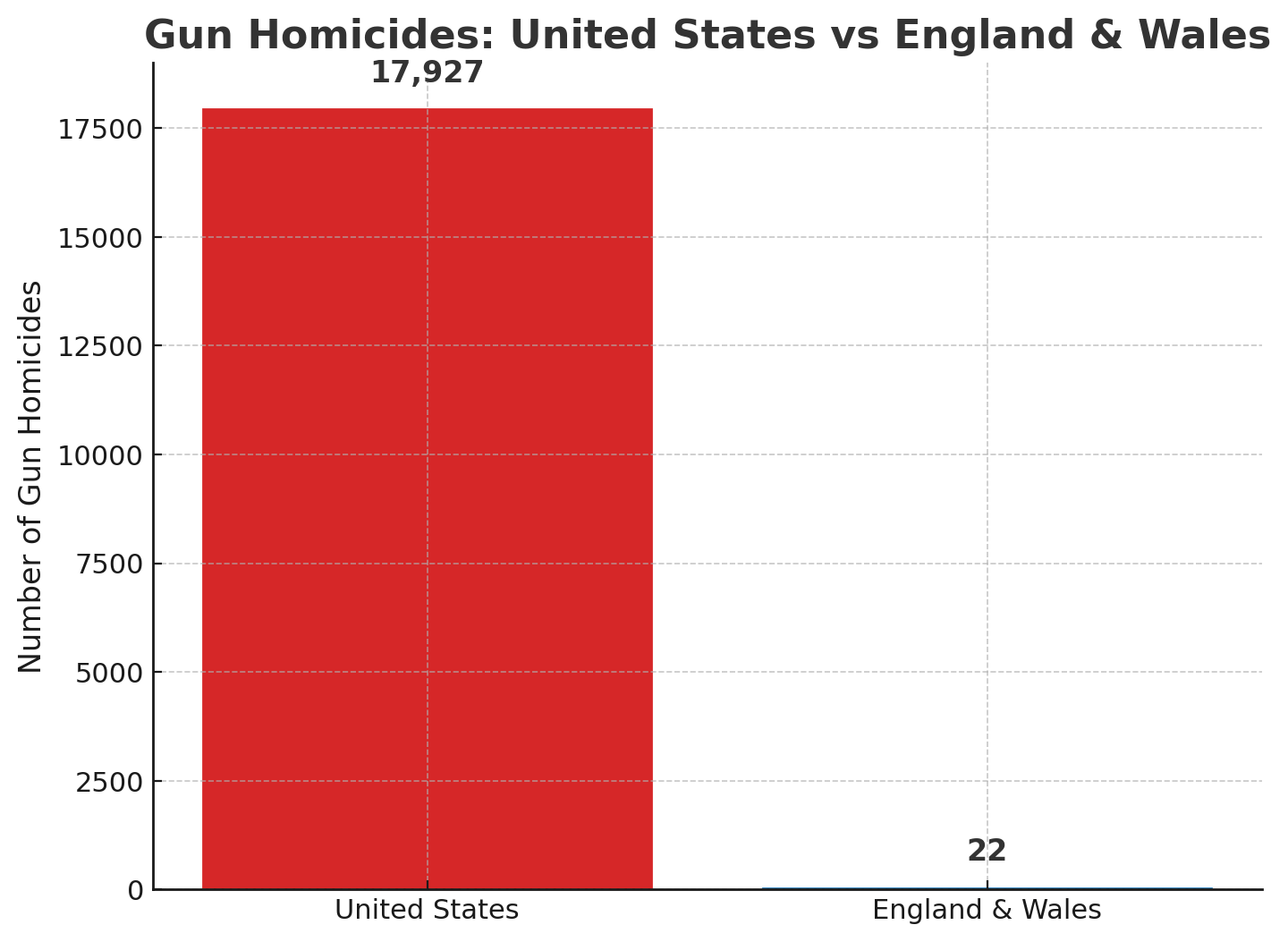
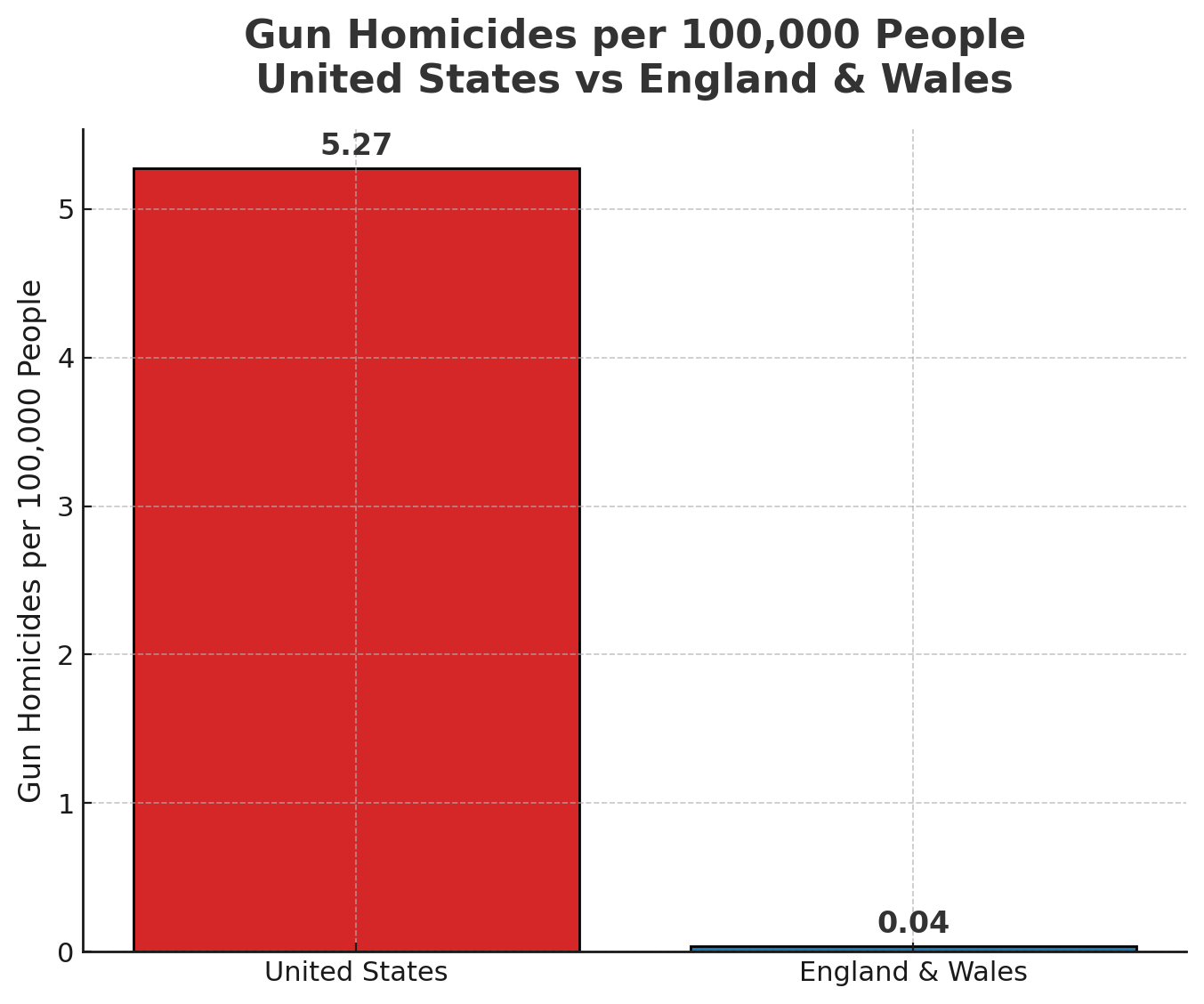
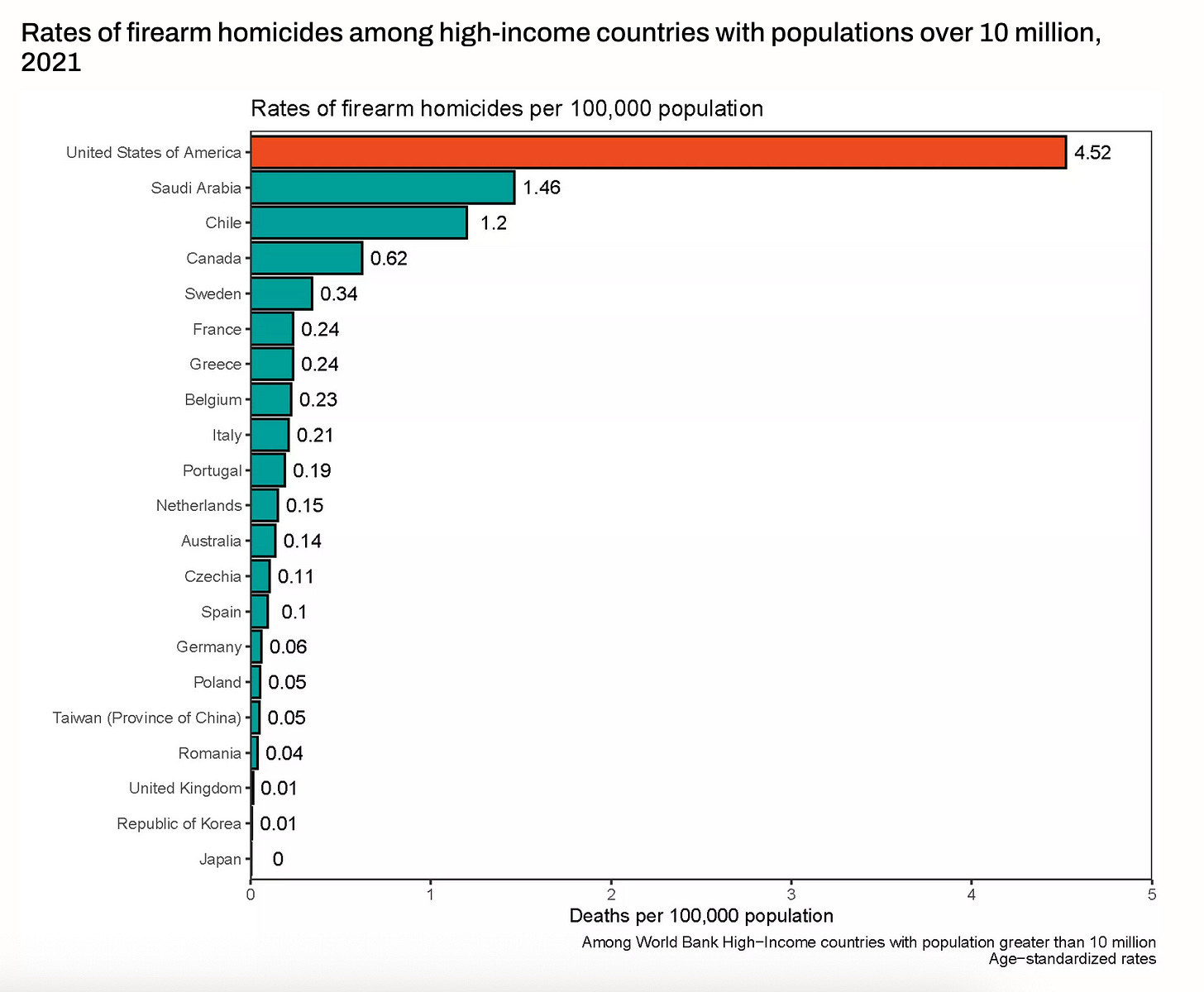



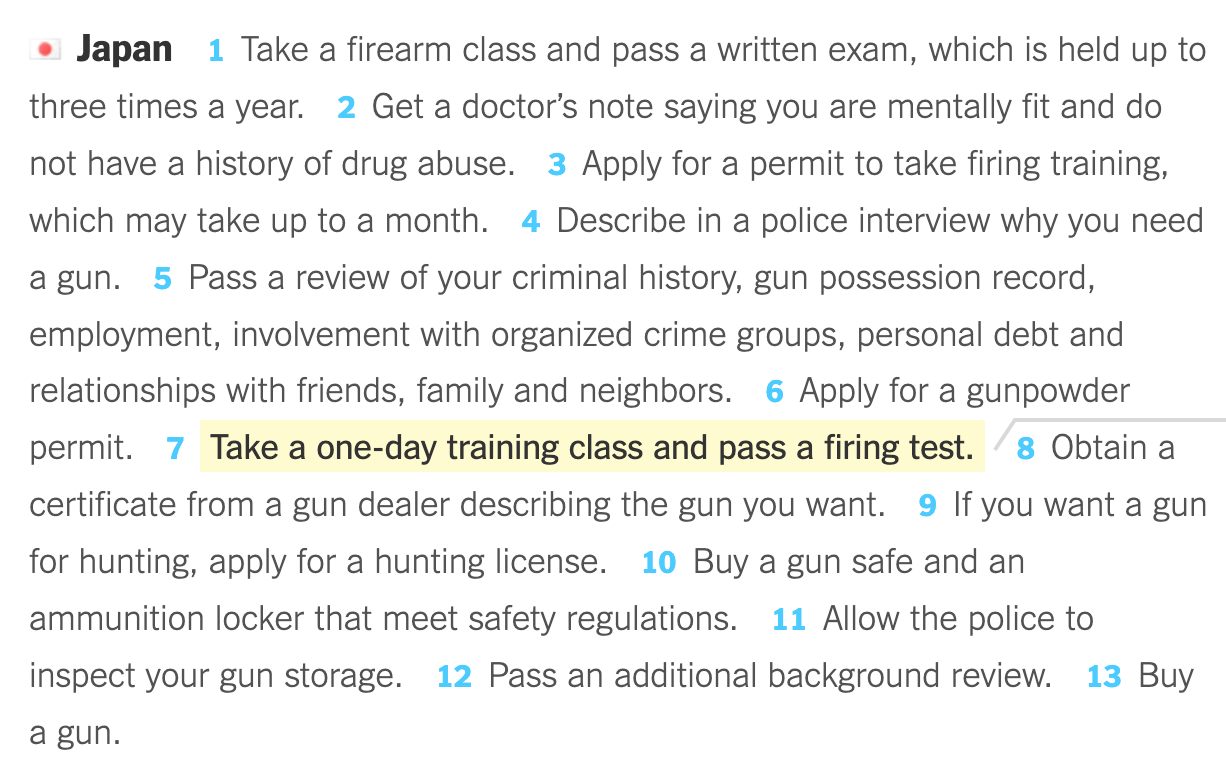
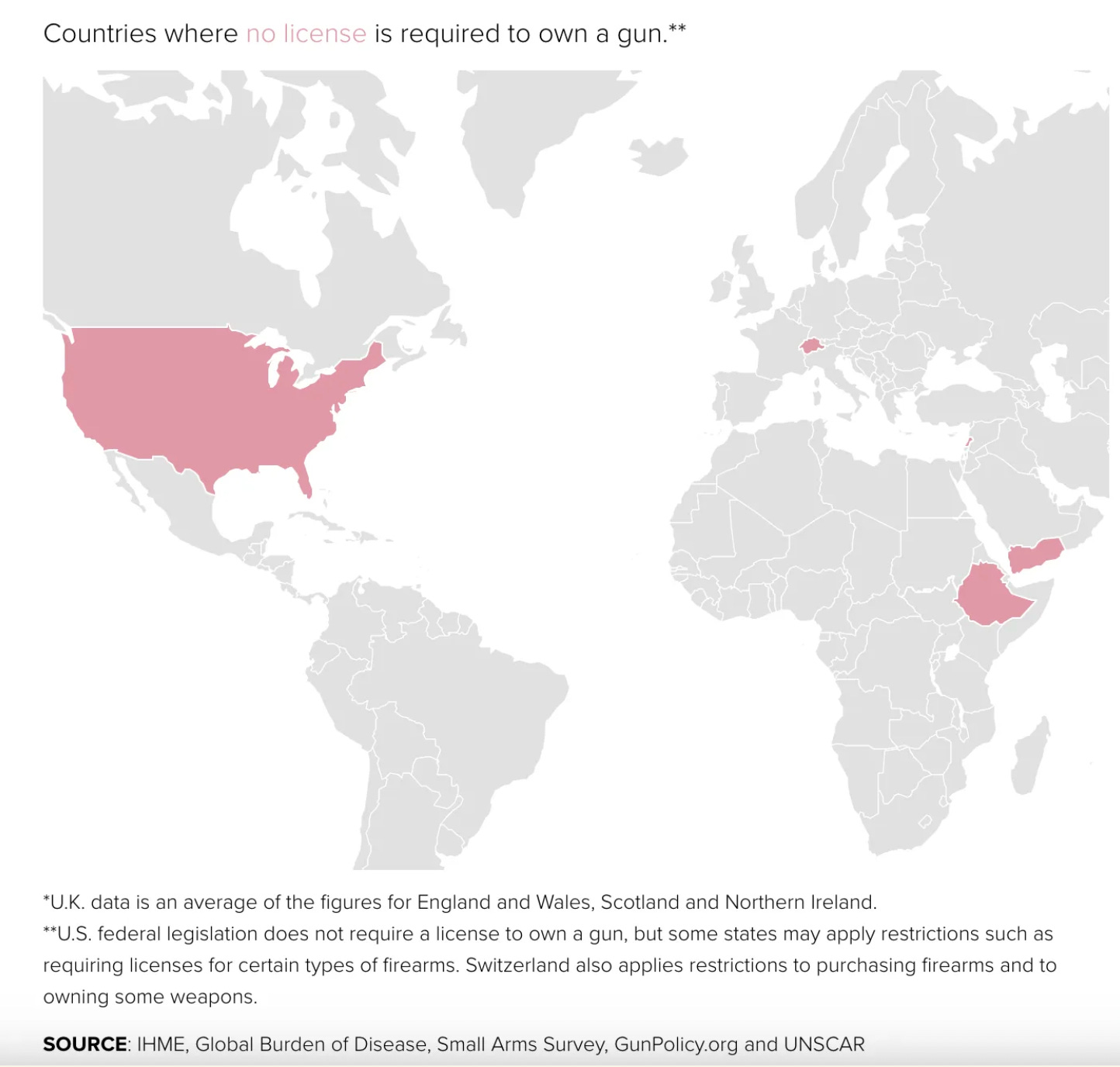

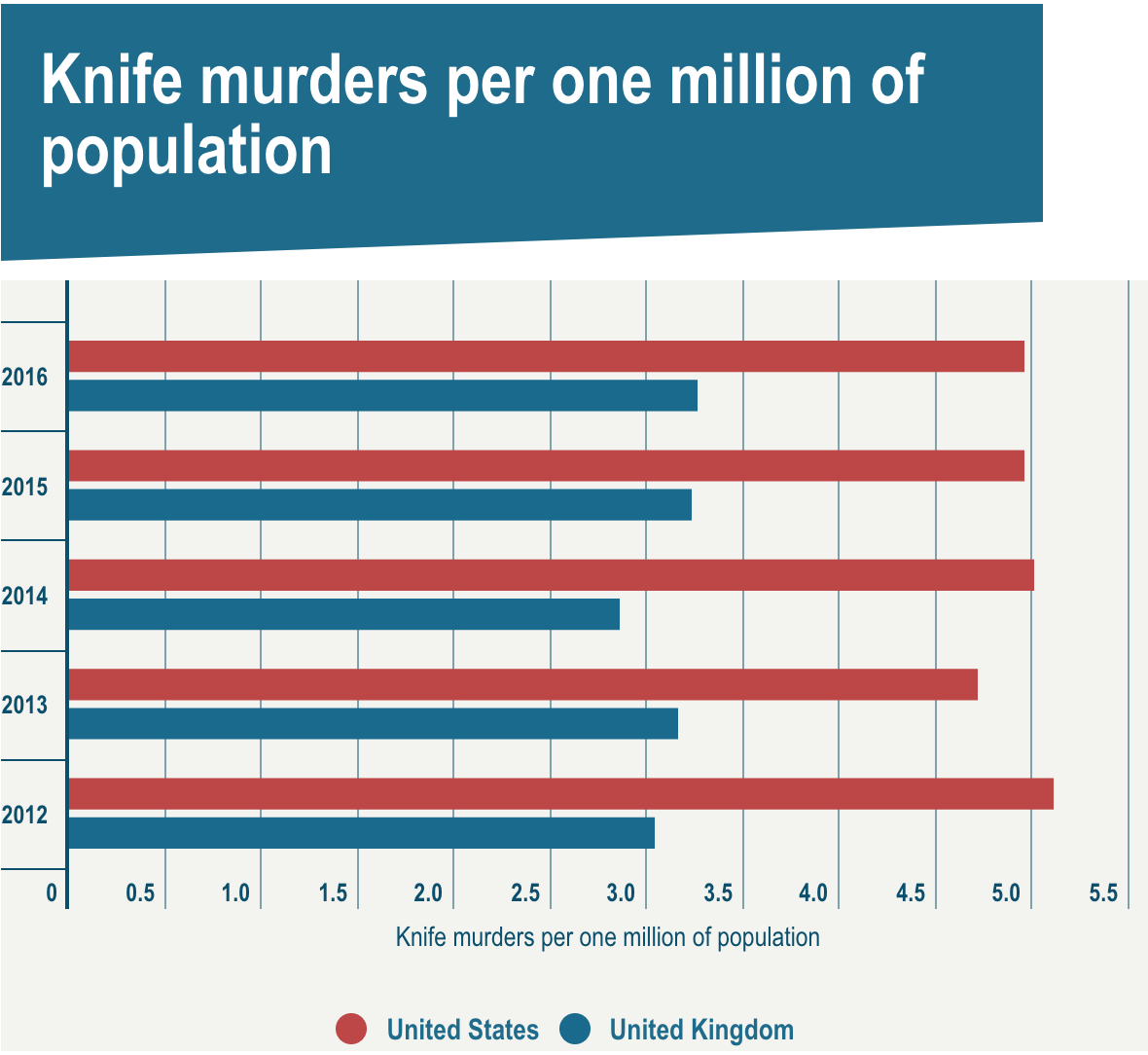
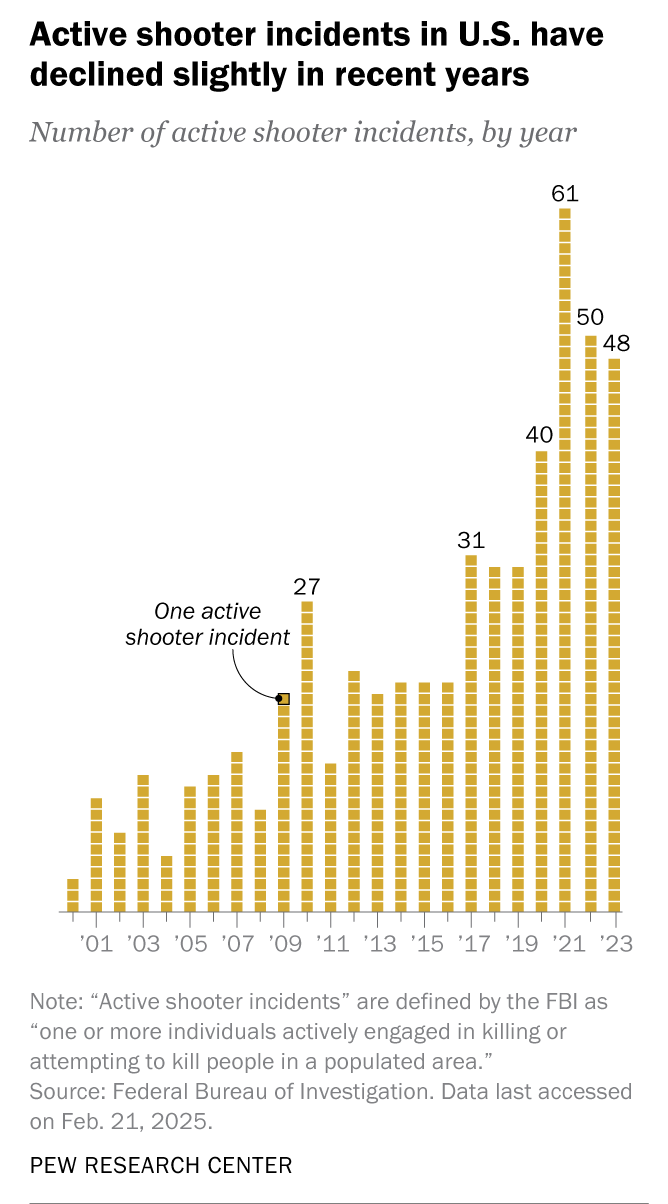
There's no excuse for the continued mass slaughter by firearms of people in the USA. It continues because it's politically expedient for the Republican Party to advance the myth that the Second Amendment disqualifies any attempt to regulate an individual's right to bear arms. It's useless to point out to Republicans that -- when the Second Amendment was passed -- there were no such firearms as AK-47s available for the populace to wield. And so -- with the Republican Party still remaining politically viable (however insane) in the electorate, the carnage continues.
I begin to feel, more and more, that the United States of America, which began as a noble experiment (however flawed) in self-government, has become an experiment that is moving rapidly towards failure. A nation that continues to privilege any nut with a burning resentment and access to a gun over a seven year old kid's right to grow up and live his or her life is a nation that has descended into psychosis. Need further proof of that assertion? Look at who is sitting in the Oval Office. A mentally sound polity would never have allowed Donald Trump to get anywhere near the White House in the first place, let alone electing him... twice.
Excellent essay. Thank you. It always amazes me that duck hunters can only hunt with shotguns limited to three shots, but those hunting people can employ the highest-capacity magazines available. I suppose there is something nice about a society that cares so much about waterfowl, but it might be nice to see evidence of similar concerns for humans.